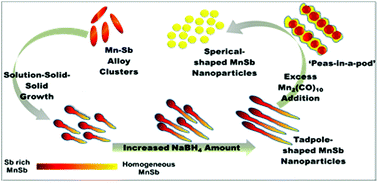Anisotropic manganese antimonide nanoparticle formation by solution–solid–solid growth mechanism: consequence of sodium borohydride addition towards reduced surface oxidation and enhanced magnetic moment†
Abstract
A new approach to the solution-phase synthesis of manganese antimonide nanoparticles was developed to reduce competitive oxide formation by exploitation of sodium borohydride (NaBH4) (0.53–2.64 mmol) as a sacrificial reductant. However, in the presence of near-stoichiometric precursor amounts of manganese carbonyl and triphenyl antimony, the introduction of NaBH4 results in a different growth mechanism, Solution–Solid–Solid (SSS), leading to tadpole-shaped manganese antimonide nanoparticles with antimony-rich heads and stoichiometric manganese antimonide tails. We hypothesize that a solid antimony-rich manganese antimonide cluster acts as an initiator to tail growth in solution. Notably, the length of the tail correlated with the amount of NaBH4 used. Interestingly, these anisotropic particles can be transformed progressively into spherical-shaped nanoparticles upon the addition of excess manganese carbonyl. The anisotropic manganese antimonide particles possess saturation magnetizations ca. twenty times higher than that reported for MnSb nanoparticles prepared without NaBH4, attributed to limitation of oxidation.

- This article is part of the themed collection: International Year of the Periodic Table: Applications for magnetic materials


 Please wait while we load your content...
Please wait while we load your content...
